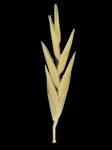
T. angusta spikelet.

T. angusta habitat.
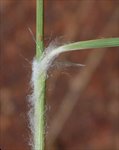
T. angusta orifice, woolly form.

T. angusta orifice, straight-haired form.
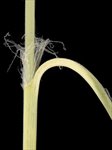
T. angusta orifice, straight-haired form.
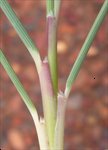
T. angusta orifice, glabrous form.
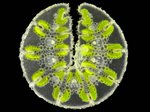
T. angusta leaf section.
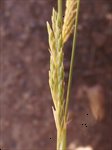
T. angusta inflorescence branch.
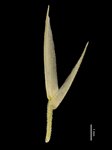
T. angusta glumes.
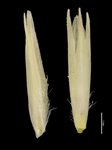
T. angusta lemmas.
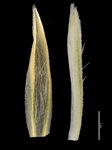
T. angusta paleas.

T. anugsta map.
Name
Triodia angusta N.T.Burb.
Citation
J. Roy. Soc. Western Australia 30:26–27 (1946)Derivation
angusta — from the Latin angustus, narrow, in reference to either the leaf blades or the inflorescence (the species’ author was not specific).Common name
Blue Buck Spinifex (Burbidge 1946)
Synonyms
None
Diagnostic features
Foliage non-resinous, dull green to slightly bluish-green; leaf sheath surfaces glabrous or woolly; orifice lacking hairs, or woolly, or with stiff straight hairs; leaf blades amphistomatous (hard-type); longest basal pedicels short, up to 1.5 mm long; spikelets dense and secund (all oriented to one side) on panicle branches; lower glume triangular to narrowly lanceolate, L:W 3–6, 1–3-nerved, glumes usually asymmetric with the lower glume about 2/3 as long as the upper glume (occasionally some or all glumes in an inflorescences ±symmetric); lemmas shortly lobed, almost glabrous or hairy, uniformly textured; midlobe of lowest lemma 0.3–0.9 mm long; palea hairy, distinctly keeled but not or scarcely winged.
Habitat
Usually associated with drainage lines and alluvial plains, over stones, gravel or alluvial clay; occasionally occurs on rocky slopes, on limestone, or on coastal sand.
Distribution and frequency
Endemic to north-western Australia. Widespread throughout the whole Pilbara and surrounds, rare and scattered in Great Sandy and Little Sandy Deserts, Gascoyne and Carnarvon bioregions.
Similar species
Triodia angusta belongs to the Angusta-Wiseana group, by virtue of having amphistomatous (hard-type) leaf blades and 1–3-nerved glumes.
Triodia secunda shares with T. angusta the densely packed, secund (one sided) panicle branches, but can be distinguished by the stiff fimbriae at the orifice (see image under T. secunda). Triodia angusta is glabrous, woolly hairy or straight-hairy at the orifice and lacks stiff fimbriae).
Triodia wiseana usually has stiff hairs extending onto the leaf blade (when T. angusta hairs extend onto the leaf blade they are invariably woolly). Forms of T. wiseana with stiff hairs only near the orifice can be confused with T. angusta, but have more distant spikelets with the longest basal pedicels >3 mm long (spikelets densely clustered and secund, with longest basal pedicels <2 mm long in T. angusta).
Triodia longiceps is vegetatively very similar to glabrous forms of T. angusta, but can be distinguished by having less dense spikelets that are arranged all around the branch (not secund), and the longest basal pedicels 1–4.5 mm long (spikelets dense, secund and longest basal pedicels 0.5–1.5 mm in T. angusta).
Some members of the Basedowii group, especially the species with longer leaves such as T. basedowii and T. glabra are vegetatively similar to T. angusta but have many-nerved (≥6)glumes (1–3 nerved in T. angusta).Conservation status
Not considered at risk.
Identification without florets
Old inflorescences retain the secund arrangement (all oriented more to one side than the other) of spikelets on the panicle branches, and the (usually) asymmetric glumes, which distinguishes T. angusta from all other species except T. secunda. Triodia secunda differs in having stiff fimbriae at the blade/sheath junction (glabrous, woolly or with straight soft hairs in T. angusta).
Variation
There is considerable variation in the density of the indumentum. Orifice hairs vary from 0.5–7 mm long, and are straight to wavy, while the sheath surface can lack hairs (glabrous) or be sparsely to densely woolly; these traits are usually uniform within a population. Glabrous plants occur most often in the Chichester sub-bioregion, where they can be easily mistaken for T. longiceps unless inflorescence and glume features are checked. Plants can also vary significantly in number of florets, from 3–12 per spikelet. Glumes are usually asymmetric, with the lower glume only c. 2/3 as long as the upper glume, but some sub-equal glume pairs can occur within an inflorescence, and rarely on most of the inflorescences.
Notes
The concept of T. angusta used here is effectively the same as Lazarides (1997), Lazarides et al. (2005) and Ausgrass (Sharp & Simon, 2002; Simon & Alonso, 2014), and the descriptions therein are all accurate; we here include their single Pilbara record of T. pascoeana, which has been confirmed to be a misidentification.
Not palatable to stock (Burbidge 1946).
Reported to be killed by fire and not resprouting (Rice & Westoby 1999, from a single observed location).